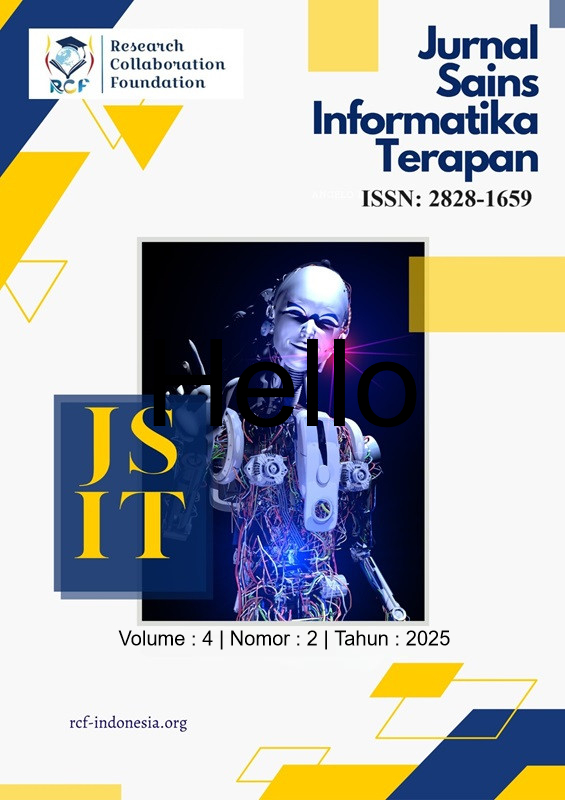Klasifikasi Kedelai Gmo Dan Non-Gmo Menggunakan Metode Convolutional Neural Network
Main Article Content
Abstract
The rapid advancement of Genetically Modified Organisms (GMO) in agriculture raises concerns regarding food safety, labeling, and consumer protection, especially in soybean commodities. Due to the high visual similarity between GMO and and non-GMO soybeans, traditional identification methods such as molecular testing are often impractical for real-time inspection. This research proposes a classification approach using Convolutional Neural Network (CNN) to automatically distinguish between GMO and non-GMO soybean seeds based on digital images. The dataset used consists of 1,000 soybean seed images, evenly divided between GMO and non-GMO categories, collected using a controlled imaging setup. The preprocessing stage involved cropping, resizing images to 128x128 pixels, and pixel normalization. The dataset was then split into a 70% training set, 10% validation set, and 20% test set to ensure robust model evaluation. The CNN model architecture includes convolutional, pooling, and dense layers, trained using the Adam optimizer and categorical crossentropy loss function. The evaluation results show that the model achieved a test accuracy of 99.00%, with high precision, recall, and F1-score for both classes. These findings demonstrate that CNN can be used to classify soybean seeds without manual feature extraction, offering a practical solution for quality control in agriculture and food processing industries.
Article Details

This work is licensed under a Creative Commons Attribution-ShareAlike 4.0 International License.
References
L. F. Pusposari, “Analisis Permintaan Kedelai Di Indonesia,” J-PIPS (Jurnal Pendidik. Ilmu Pengetah. Sos., vol. 1, no. 1, p. 77, 2014, doi: 10.18860/j-pips.v1i1.6813.
A. R. Ruvananda and M. Taufiq, “Analisis faktor-faktor yang mempengaruhi impor beras di Indonesia,” Kinerja, vol. 19, no. 2, pp. 195–204, 2022, doi: 10.30872/jkin.v19i2.10924.
S. A. Pramono, “Inovasi Potensi Pangan Kacang Kedelai: Dari Olahan Produk Hingga Pemasaran Online,” J. Atma Inovasia, vol. 1, no. 3, pp. 402–408, 2021, doi: 10.24002/jai.v1i3.3983.
V. Agustiarini and D. Permata Wijaya, “Jurnal Penelitian Sains,” J. Penelit. Sains, vol. 21, no. 3, pp. 163–167, 2021.
A. M. Ulfa, “Identification of GMO And NON-GMO Tempeh Images Using The Convolutional Neural Network,” vol. 17, no. 1, pp. 14–24, 2024.
E. R. Septiana, F. A. Fiolana, and D. Erwanto, “Klasifikasi Kualitas Citra Kedelai Hitam (Malika) Menggunakan Metode K-Nearest Neighbor,” JEECOM J. Electr. Eng. Comput., vol. 4, no. 2, pp. 79–86, 2022, doi: 10.33650/jeecom.v4i2.4469.
D. Sharma and A. Jain, “A CNN-based approach for quality grading of soybean seeds,” J. Food Qual., vol. 2021, pp. 1–9, 2021, doi: 10.1155/2021/6693203.
D. Irfansyah, M. Mustikasari, and A. Suroso, “Arsitektur Convolutional Neural Network (CNN) Alexnet Untuk Klasifikasi Hama Pada Citra Daun Tanaman Kopi,” J. Inform. J. Pengemb. IT, vol. 6, no. 2, pp. 87–92, 2021, doi: 10.30591/jpit.v6i2.2802.
M. Effendi, N. H. Ramadhan, and A. Hidayat, “Image-based Quality Identification of Black Soybean (Glycine soja) Using Convolutional Neural Network,” Ind. J. Teknol. dan Manaj. Agroindustri, vol. 12, no. 1, pp. 73–88, 2023, doi: 10.21776/ub.industria.2023.012.01.7.
A. P. Ningrum, S. Winarno, and V. Praskatama, “JOURNAL OF APPLIED COMPUTER SCIENCE AND TECHNOLOGY ( JACOST ) Klasifikasi Kualitas Biji Kedelai Menggunakan Transfer Learning Convolutional Neural Network Dan SMOTE,” vol. 5, no. 2, pp. 155–164, 2024.
L. S. Pieters, U. Pradita, S. B. Park, and K. Tangerang, “DEVELOPMENT OF AUTOMATIC WASTE CLASSIFICATION SYSTEM USING CNN BASED DEEP LEARNING TO SUPPORT SMART WASTE MANAGEMENT OTOMATIS MENGGUNAKAN DEEP LEARNING BERBASIS,” vol. 10, no. 1, pp. 214–224, 2025.
S. P. Backar, P. Purnawansyah, H. Darwis, and W. Astuti, “Hybrid Fourier Descriptor Naïve Bayes dan CNN pada Klasifikasi Daun Herbal,” J. Inform. J. Pengemb. IT, vol. 8, no. 2, pp. 126–133, 2023, doi: 10.30591/jpit.v8i2.5186.
E. Triyana, T. Hadi, and W. Atmaja, “Jurnal Biologi Tropis Effectiveness of Elephant Grass ( Pennisetum purpureum ) Green Fertilizer on the Growth of Soybean Plants ( Glycine max L . Merrill ),” 2024.
R. D. Isna, Hapsoh, and A. E. Yulia, “Penerapan Prinsip Etika Lingkungan Pada Teknologi Rekayasa Genetik Tanaman Dan Regulasi Keamanan Produk Rekayasa Genetika,” J. Senpling Multidisiplin Indones., vol. 1, no. 1, pp. 8–19, 2023, [Online]. Available: http://senpling.pelantarpress.co.id/8
J. E. Widyaya and S. Budi, “The Effect of Preprocessing on the Classification of Diabetic Retinopathy with the Transfer Learning Convolutional Neural Network Approach,” J. Tek. Inform. dan Sist. Inf., vol. 7, no. 1, pp. 110–124, 2021.
P. A. Nugroho, I. Fenriana, and R. Arijanto, “Implementasi Deep Learning Menggunakan Convolutional Neural Network (CNN) Pada Ekspresi Manusia,” Algor, vol. 2, no. 1, pp. 12–21, 2020.
M. Rijal, A. M. Yani, and A. Rahman, “Deteksi Citra Daun untuk Klasifikasi Penyakit Padi menggunakan Pendekatan Deep Learning dengan Model CNN,” J. Teknol. Terpadu, vol. 10, no. 1, pp. 56–62, 2024, doi: 10.54914/jtt.v10i1.1224.
B. Yanto, L. Fimawahib, A. Supriyanto, B. H. Hayadi, and R. R. Pratama, “Klasifikasi Tekstur Kematangan Buah Jeruk Manis Berdasarkan Tingkat Kecerahan Warna dengan Metode Deep Learning Convolutional Neural Network,” INOVTEK Polbeng - Seri Inform., vol. 6, no. 2, p. 259, 2021, doi: 10.35314/isi.v6i2.2104
N. Sitohang, “Jurnal Sains Informatika Terapan ( JSIT ),” Penerapan Data Min. Untuk Peringatan Dini Banjir Menggunakan Metod. Klastering K-Means, vol. 2, no. 1, pp. 16–20, 2023.
K. Yudiono, “Peningkatan Daya Saing Kedelai Lokal Terhadap Kedelai Impor Sebagai Bahan Baku Tempe Melalui Pemetaan Fisiko-Kimia,” Agrointek, vol. 14, no. 1, pp. 57–66, 2020, doi: 10.21107/agrointek.v14i1.6311.

